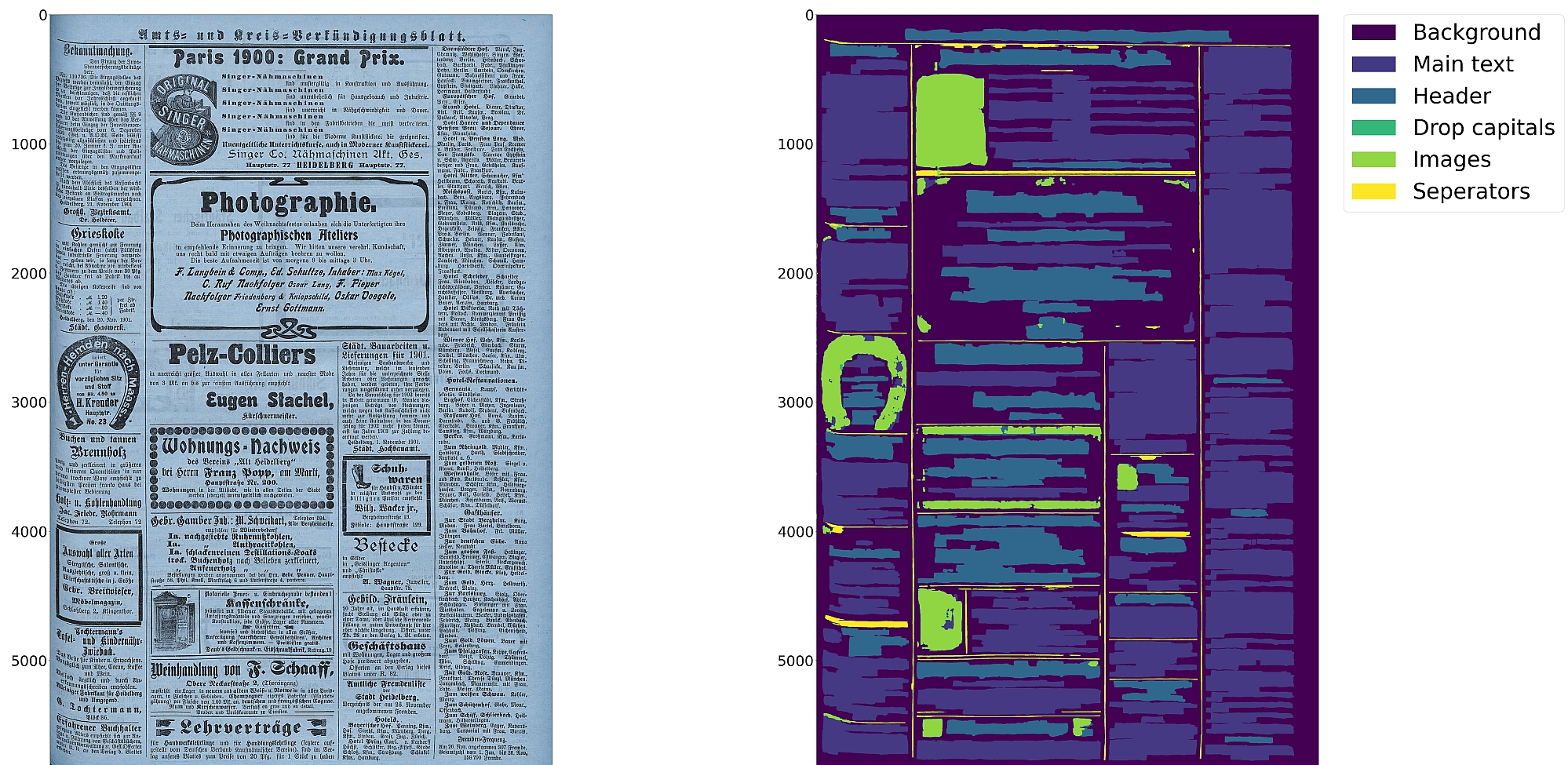|
|
||
|---|---|---|
| .circleci | ||
| .github/workflows | ||
| qurator | ||
| tests | ||
| .gitignore | ||
| CHANGELOG.md | ||
| LICENSE | ||
| Makefile | ||
| ocrd-tool.json | ||
| README.md | ||
| requirements-test.txt | ||
| requirements.txt | ||
| setup.py | ||
Eynollah
Document Layout Analysis (segmentation) using pre-trained models and heuristics
Features
- Support for up to 10 segmentation classes:
- background, page border, text region, text line, header, image, separator, marginalia, initial, table
- Support for various image optimization operations:
- cropping (border detection), binarization, deskewing, dewarping, scaling, enhancing, resizing
- Text line segmentation to bounding boxes or polygons (contours) including for curved lines and vertical text
- Detection of reading order
- Output in PAGE-XML
- OCR-D interface
Installation
Python versions 3.8-3.11 with Tensorflow versions >=2.12 on Linux are currently supported. Unfortunately we can not currently support Windows or MacOS.
Windows users may be able to successfully run the tool through WSL.
For (limited) GPU support the CUDA toolkit needs to be installed.
You can either install via
pip install eynollah
or clone the repository, enter it and install (editable) with
git clone git@github.com:qurator-spk/eynollah.git
cd eynollah; pip install -e .
Alternatively, you can run make install or make install-dev for editable installation.
Models
Pre-trained models can be downloaded from qurator-data.de.
In case you want to train your own model to use with Eynollah, have a look at sbb_pixelwise_segmentation.
Usage
The command-line interface can be called like this:
eynollah \
-i <image file> \
-o <output directory> \
-m <path to directory containing model files> \
[OPTIONS]
The following options can be used to further configure the processing:
| option | description |
|---|---|
-fl |
full layout analysis including all steps and segmentation classes |
-light |
lighter and faster but simpler method for main region detection and deskewing |
-tab |
apply table detection |
-ae |
apply enhancement (the resulting image is saved to the output directory) |
-as |
apply scaling |
-cl |
apply contour detection for curved text lines instead of bounding boxes |
-ib |
apply binarization (the resulting image is saved to the output directory) |
-ep |
enable plotting (MUST always be used with -sl, -sd, -sa, -si or -ae) |
-ho |
ignore headers for reading order dectection |
-di <directory> |
process all images in a directory in batch mode |
-si <directory> |
save image regions detected to this directory |
-sd <directory> |
save deskewed image to this directory |
-sl <directory> |
save layout prediction as plot to this directory |
-sp <directory> |
save cropped page image to this directory |
-sa <directory> |
save all (plot, enhanced/binary image, layout) to this directory |
If no option is set, the tool will perform layout detection of main regions (background, text, images, separators and marginals). The tool produces better quality output when RGB images are used as input than greyscale or binarized images.
Use as OCR-D processor
Eynollah ships with a CLI interface to be used as OCR-D processor.
In this case, the source image file group with (preferably) RGB images should be used as input like this:
ocrd-eynollah-segment -I OCR-D-IMG -O SEG-LINE -P models
Any image referenced by @imageFilename in PAGE-XML is passed on directly to Eynollah as a processor, so that e.g.
ocrd-eynollah-segment -I OCR-D-IMG-BIN -O SEG-LINE -P models
uses the original (RGB) image despite any binarization that may have occured in previous OCR-D processing steps
How to cite
If you find this tool useful in your work, please consider citing our paper:
@inproceedings{rezanezhad2023eynollah,
title = {Document Layout Analysis with Deep Learning and Heuristics},
author = {Rezanezhad, Vahid and Baierer, Konstantin and Gerber, Mike and Labusch, Kai and Neudecker, Clemens},
booktitle = {Proceedings of the 7th International Workshop on Historical Document Imaging and Processing {HIP} 2023,
San José, CA, USA, August 25-26, 2023},
publisher = {Association for Computing Machinery},
address = {New York, NY, USA},
year = {2023},
pages = {73--78},
url = {https://doi.org/10.1145/3604951.3605513}
}


